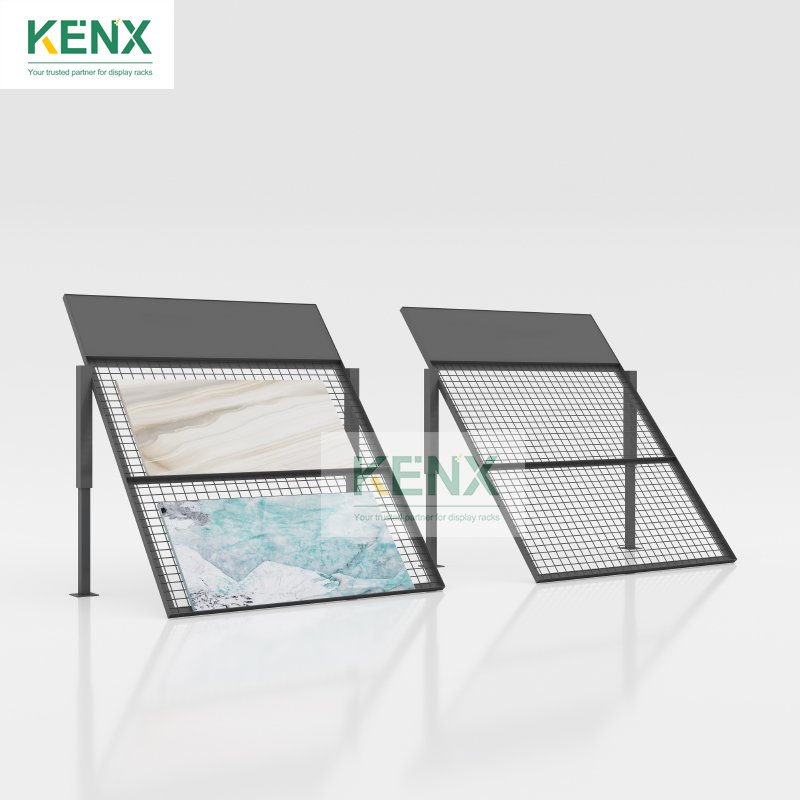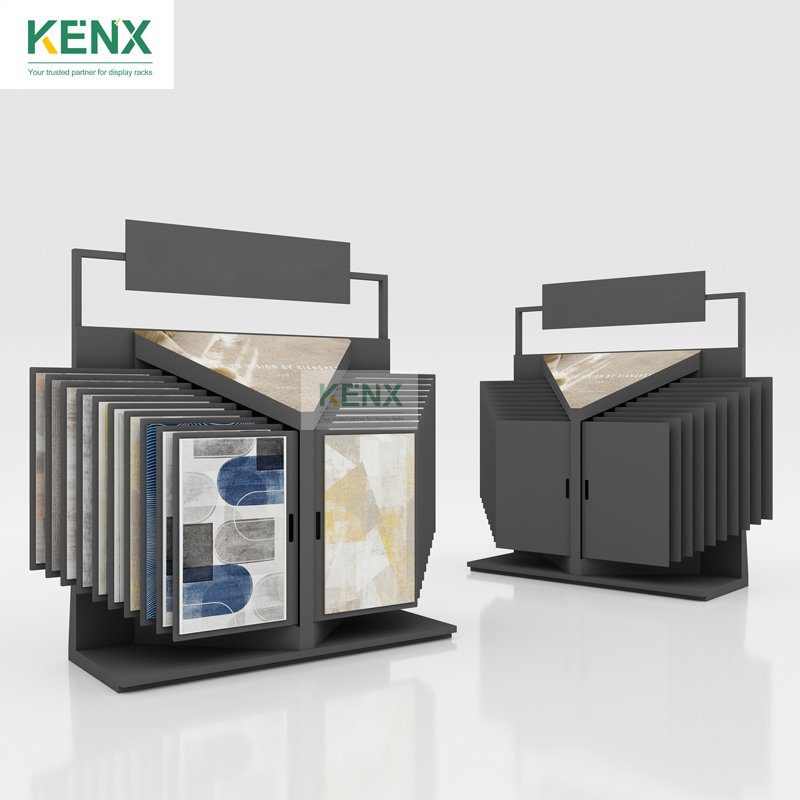The Importance of Effective Tile Showroom Displays
In the competitive world of tile retail, an effective showroom display can be the difference between a lackluster sales performance and a thriving business. The showroom floor represents a retailer’s biggest opportunity to showcase their products, set the desired ambiance, and encourage customer interaction. A well-designed display not only highlights the beauty and versatility of tile offerings but also creates an engaging environment that inspires customers to envision the possibilities for their own spaces.
By thoughtfully curating tile displays, retailers can guide customers through a seamless journey, allowing them to explore various styles, textures, and colors while fostering a sense of excitement and inspiration. An engaging showroom display has the power to elevate the customer experience, ultimately driving sales and fostering brand loyalty. Source

Key Principles for Tile Showroom Display Design
Effective tile showroom displays follow several fundamental principles to create an engaging and sales-driven environment. Clear circulation and flow throughout the space is essential, allowing customers to easily navigate and view products without feeling cramped or overwhelmed. Designing vignettes and lifestyle scenes helps customers visualize how the tiles will look in a real setting, sparking inspiration and desire.
Strategic use of lighting is crucial, with brightly illuminated display areas that highlight product details and focal points accented by spotlights or track lighting. At the same time, softer ambient lighting creates an inviting ambiance. Wherever possible, leverage natural lighting to showcase products in a warm, appealing way.
Accessibility and interaction are key, with display fixtures that encourage customers to pick up, view, and experience tile samples up close. Group products logically by style, color, texture, room type, or other defining characteristics to help customers find what they need. Balance defined product zones with open spaces that provide breathing room and ease of movement.
Overall, the layout should guide customers on a thoughtful journey while allowing freedom to explore. Well-designed displays achieve a harmonious blend of open and defined areas, creating visual interest without overwhelming the senses. Source
Types of Floor Tile Displays
Tile showrooms have a variety of display fixtures available to showcase their products effectively. One popular option is freestanding racks and shelves, which allow tiles to be displayed at different heights and angles. Modular and movable units provide flexibility to reconfigure the showroom layout. For large format tiles, sliding panels offer an ideal solution, enabling customers to easily view and inspect the full tile surface.
Pedestals and platforms elevate tiles off the floor, making them more accessible for close inspection. Bins and cubbies are perfect for displaying smaller tile samples or loose pieces. Retailers can also consider wing rack displays that allow tiles to be flipped and rotated for a 360-degree view. The key is to offer a range of display options that cater to different tile sizes, formats, and customer needs.
Strategic Lighting for Tile Displays
Lighting plays a crucial role in enhancing the visual appeal of tile displays and creating an inviting ambiance within the showroom. A well-designed lighting strategy combines various techniques to achieve the desired effect. Firstly, it’s essential to brightly illuminate the display areas to ensure tiles are showcased in their true colors and textures. Strategically placed spotlights can be used to accentuate focal points, drawing attention to feature displays or highlighting specific tile collections.
While bright lighting is essential for product evaluation, softer ambient lighting can create a warm and inviting atmosphere throughout the showroom. This can be achieved through the use of recessed lighting, wall sconces, or even stylish pendant lights. Additionally, incorporating natural light wherever possible can enhance the overall ambiance and provide a more realistic representation of how the tiles will appear in a residential or commercial setting. Source

Layout and Circulation Design
The layout and circulation of a tile showroom play a crucial role in guiding customers through the space and ensuring an optimal shopping experience. According to Shopify’s guide on retail store layouts, the flow of traffic should be carefully considered to prevent bottlenecks and encourage exploration of the entire showroom.
One effective strategy is to create open spaces that allow for ease of movement, while also defining distinct zones or vignettes dedicated to specific tile styles, colors, or room types. These dedicated areas not only organize the products but also help customers visualize how the tiles might look in their own homes.
When designing the layout, it’s essential to place focal displays and high-impact products in areas with maximum visibility, such as near the entrance or along main traffic paths. This ensures that customers are immediately drawn to the showroom’s most impressive offerings, sparking interest and encouraging further exploration.
Additionally, the layout should guide customers through the showroom in a logical and intuitive manner, without creating confusion or dead ends. This can be achieved through thoughtful placement of displays, strategic use of pathways, and clear signage or visual cues.
Creating Vignettes and Lifestyle Scenes
Effective tile displays go beyond simply showcasing individual products – they create immersive vignettes and lifestyle scenes that inspire customers with design ideas. By arranging tiles in realistic settings, such as a kitchen backsplash mock-up or a bathroom floor vignette, retailers can help customers visualize how the tiles will look and function in their own spaces. According to XY Display Stand, vignettes “allow customers to experience products in a real-world context, sparking their imagination and making it easier for them to envision the tiles in their homes.”
These lifestyle displays can be enhanced with complementary decor elements, such as cabinetry, plumbing fixtures, furniture pieces, and accessories. Grouping tiles by style, color palette, or intended room can further aid in creating cohesive scenes that resonate with customers. With thoughtful arrangement and attention to detail, vignettes have the power to captivate customers and elevate the showroom experience from a mere product showcase to an inspiring design destination.
Grouping and Organizing Tile Products
Effective grouping and organization of tile products is crucial for creating an engaging and intuitive showroom experience. Grouping tiles by style, color, texture, or intended room can help customers easily browse and visualize different options. According to Tile Display Stand, “Whether through color coordination, size variations, or style grouping, display stands provide a clear structure that guides customers through the options.”
Consider grouping tiles by aesthetic style, such as contemporary, rustic, or traditional. Color-coding displays can also be an effective way to organize tiles, making it easier for customers to narrow down their preferences. Grouping by texture, whether glossy, matte, or textured, can also help customers envision the desired look and feel. Finally, organizing tiles by intended room or application, such as bathroom, kitchen, or outdoor, can streamline the selection process for customers.
Clear signage and labeling are essential for communicating the logic behind each grouping. This not only enhances the browsing experience but also showcases the breadth of your tile collection. By thoughtfully grouping and organizing tile products, showrooms can create a more intuitive and visually appealing environment that empowers customers to explore and discover their ideal tile options.

Display Fixtures for Accessibility and Interaction
To truly showcase tile products and encourage customer engagement, retailers should invest in display fixtures that allow for easy accessibility and hands-on interaction. Movable units like freestanding racks, shelves, and cubes enable customers to view tiles from multiple angles and handle samples up close. For large format tiles, sliding panel displays let customers see full tile faces while remaining mobile.
Pedestals and platforms that elevate tiles off the floor put products at an ideal viewing height while also allowing customers to walk around displays. Bins and cubbies are perfect for housing smaller tile samples that can be picked up and examined closely. When selecting fixtures, prioritize mobility, adjustability, and open access so customers feel empowered to fully experience your product range.
Enhancing the Overall Showroom Experience
Beyond the tile displays themselves, several elements can contribute to an elevated and inspiring showroom atmosphere. Providing clear product information and signage allows customers to learn about tile offerings, installation requirements, care instructions, and more. Comfortable seating areas give shoppers a chance to rest and visualize how the tiles could work in their own spaces.
Thoughtful decor pieces like artwork, accessories, and lifestyle vignettes can spark inspiration and help customers envision the tiles in a real-world setting. Offering refreshments, free WiFi, and playing ambient music creates a welcoming, relaxing ambiance that encourages guests to linger. Enhancing the overall visual experience through strategic design elements elevates the showroom from a mere product gallery to an engaging, memorable destination.
Inspiration and Examples
When designing a tile showroom display, it’s helpful to draw inspiration from stunning examples that put the key principles into practice. Retailers like Why Tile showcase the latest tile trends through lifestyle vignettes, piquing customer interest with bathroom and kitchen scenes featuring eye-catching tile designs.
House Beautiful offers a stunning gallery of bathroom tile inspiration, demonstrating how to creatively mix colors, textures, and patterns. These examples highlight strategic lighting, layout flow, and imaginative display fixtures that allow customers to fully experience the tile products.
Well-executed showrooms balance open space for circulation with defined product zones. They incorporate elements like comfortable seating areas, decorative accents, and refreshment stations to enhance the overall experience. By studying inspirational examples, showroom designers can gain ideas for translating the principles of effective display design into reality.
Conclusion and Key Takeaways
Designing an engaging and effective floor tile showroom display is crucial for showcasing products, enhancing the customer experience, and driving sales. By following key principles such as creating a clear layout with defined zones and vignettes, utilizing strategic lighting, and incorporating interactive display fixtures, retailers can highlight their offerings in an inspiring and immersive environment.
Grouping tiles by style, color, or texture, and providing ample space for circulation and accessibility, allows customers to easily navigate and interact with the products. Incorporating comfortable seating areas, refreshments, and other amenities further elevates the overall showroom experience, encouraging visitors to linger and explore the extensive tile selections.
Ultimately, a well-designed tile showroom display not only showcases the products but also reflects the brand’s identity and commitment to exceptional customer service. By implementing these strategies, retailers can create a memorable and engaging space that inspires customers and fosters a positive shopping experience, leading to increased sales and customer loyalty. As stated by INSCA, “Renewing your showroom is an opportunity to transform your business and offer a unique shopping experience to your customers.”
